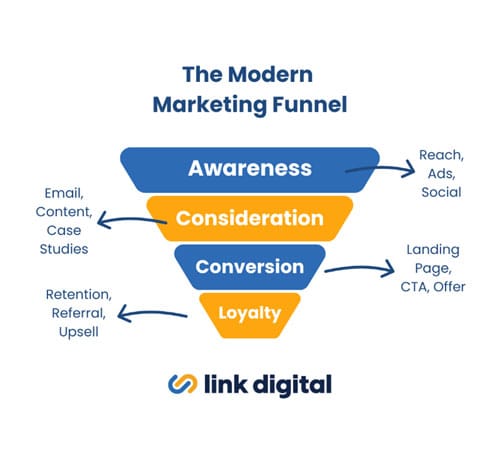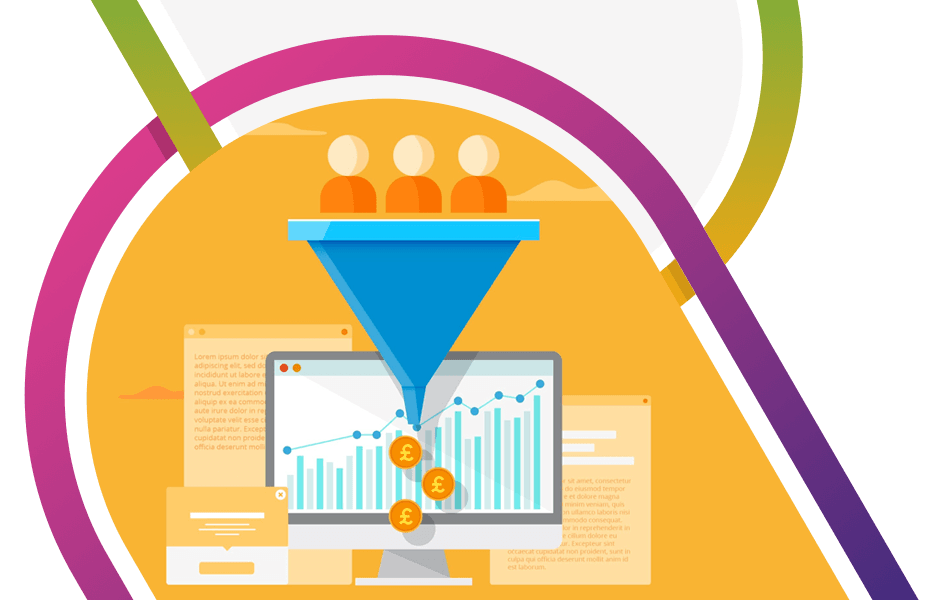
Free Digital Marketing Review
Elevate your online strategy with a personalised report and expert insights. Achieve your business goals faster!
Understanding the Marketing Funnel: Beyond Awareness to Sustainable Growth
The marketing funnel is one of the most well-known concepts in marketing, but it’s also one of the most misunderstood. You’ve probably seen the familiar triangle shape dozens of times, labelled from Awareness at the top to Conversion at the bottom. But if you’re already deep into your marketing strategy, you know it’s not that simple.
The funnel isn’t a fixed journey. It’s dynamic, non-linear and often multitouch. With fragmented attention spans and diverse consumer behaviours, marketers need to view the funnel not as a rigid model, but as a framework that can be adapted to modern buying behaviour.
So, what does that look like in practice?
The Modern Funnel: From Linear to Layered
Traditionally, the funnel followed three simple stages:
- Top of Funnel (TOFU) – Awareness
- Middle of Funnel (MOFU) – Consideration
- Bottom of Funnel (BOFU) – Conversion
- Post-Funnel – Loyalty
But buyers don’t move in a straight line. A potential customer might come across your brand on social media, bounce, read a blog three weeks later, subscribe to your email list after downloading a guide, and finally convert after a retargeting campaign.
This has led to a shift in how we utilise the funnel. It’s not about pushing people down a linear path. It’s about creating value at every touchpoint, allowing people to opt in and out, and being prepared with the right content when they return.
The funnel should be viewed as a layered ecosystem where each stage must work independently and in conjunction with the others.

TOFU: Rethinking Awareness
Top of funnel marketing is often treated like a numbers game. Get in front of as many people as possible and hope some stick. That might work to a degree, but awareness without relevance is just noise.
Instead, TOFU should be about qualified awareness. Targeting the right audience with content that’s not only attention grabbing but useful and aligned with their stage of research. Paid ads, SEO driven blog content, social video, and downloadable resources work best here when paired with strong targeting and segmentation.
Key metrics at this stage include:
- Impressions and reach
- Click-through rates
- Engagement rates
- New sessions or first-time visitors
But don’t mistake volume for impact. If your bounce rate is high or time on page is low, you may be casting too wide a net.
MOFU: Nurture with Intent
This is where most funnels fall apart. Awareness is relatively easy to generate. Getting someone to consider your brand takes nuance seriously.
At the MOFU stage, your job is to educate and differentiate. You need to move beyond features and benefits and into problem-solving. What are the friction points in your audience’s journey? What objections do they have? What questions are they asking that your competitors aren’t answering?
Practical MOFU tactics include:
- Case studies and client stories
- Webinars or workshops
- Email drip campaigns
- Comparison guides or checklists
- Interactive content like quizzes or assessments
Retargeting also plays a key role here. With the right pixel strategy and audience segmentation, you can nurture previously engaged visitors with tailored messages based on their behaviour.
It’s worth noting that this stage often gets overlooked in budget allocation. Many brands either push people to convert too quickly or keep them in an awareness mode for too long. A well optimised middle funnel should do the heavy lifting in persuading, educating and building trust.
BOFU: Conversion, Not Closure
Bottom of funnel activity is where leads are expected to take action, whether that’s booking a call, starting a trial or making a purchase.
However, too often, the focus here is on the sale rather than the solution. People don’t want to feel pushed; they want to feel confident. That means your conversion content needs to focus on reducing friction, building reassurance and reinforcing the value they’re about to receive.
Effective BOFU assets include:
- Clear, simple landing pages
- Client testimonials
- Free audits or consultations
- Pricing breakdowns or ROI calculators
- Strong CTAs paired with timely follow-ups
It’s also the point where the conversation can’t just be one-way. Sales and marketing alignment becomes crucial here. Are your leads sales-ready? Are they being followed up with in a way that continues the positive experience they had at earlier stages?
Remember: Conversion isn’t the end of the funnel. It’s the start of a relationship; what you do next matters just as much.
The Funnel Doesn’t End at the Sale
This is a crucial point that is often overlooked in funnel discussions. The most successful brands extend the funnel beyond conversion to include retention, advocacy, and loyalty.
You’ve invested in acquiring a customer, now maximise that value. This means:
- Offering a seamless onboarding experience
- Encouraging feedback and referrals
- Building exclusive content or communities
- Using email and content marketing to stay top of mind
A well nurtured customer can become a brand advocate, helping you fill the top of the funnel organically through reviews, testimonials and word of mouth.
Measuring Funnel Effectiveness
To understand whether your funnel is working, don’t just look at top line metrics like traffic or conversion rate in isolation.
Instead, measure how efficiently prospects move from one stage to the next. Key metrics include:
- Cost per lead (and per stage)
- Lead-to-customer ratio
- Time spent in each stage
- Drop off points and bottlenecks
- Customer lifetime value (CLTV)
Marketing automation and CRM integration are crucial in this context. The more visibility you have into how users are moving through your funnel, the more strategically you can optimise weak points.
Final Thoughts
The marketing funnel has evolved. It’s about creating a flexible, value-driven journey that meets people where they are, respects their pace and earns their trust.
At Link Digital, we treat the funnel as a living system, not a static diagram. Whether you’re refining your middle funnel content or struggling with conversion gaps, the key is to test, learn and adapt constantly.
A good funnel doesn’t just generate leads. It builds long-term relationships.

Need help with your website and marketing?
Book a FREE growth strategy session with our experts
Our award-winning team will review your website and marketing goals to provide you with crucial insight and advice.

4.9 STAR
Google reviews
With 10+ years of experience, Link Digital has helped hundreds of businesses to succeed online. We can help yours too!

